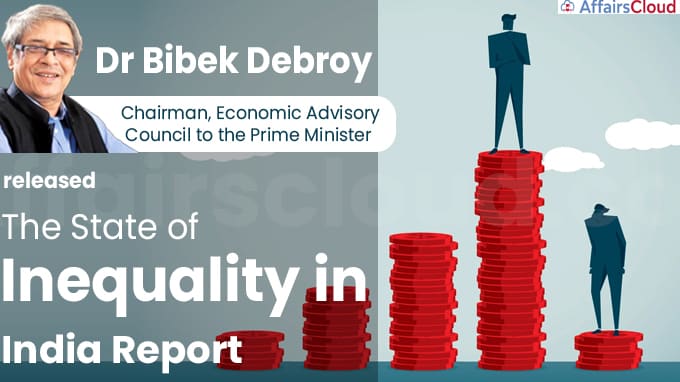
Dr. Bibek Debroy, Chairman of the Economic Advisory Council to the Prime Minister (EAC-PM), has released the State of Inequality in India Report.
- The report was written by the Institute for Competitiveness and it provides a comprehensive analysis of the depth and nature of inequality in India.
The report compiles data on inequality in the health, education, household characteristics, and labour market sectors. It’s an assessment of both inclusion and exclusion.
- Inequities in these sectors, according to the report, make the population more vulnerable and lead to multidimensional poverty.
Panellists
Dr. Poonam Gupta, Director General of the National Council of Applied Economic Research (NCAER) & a member of the EAC-PM; Dr. Charan Singh, Chief Executive of the Foundation for Economic Growth and Welfare (EGROW); and Professor Suresh Babu of the Indian Institute of Technology – Madras (IIT-M) were among the panellists for the launch of the report. Two Parts of The State of Inequality in India Report
Two Parts of The State of Inequality in India Report
i. The two components of The State of Inequality in India Report – Economic Facets and Socio-Economic Manifestations – look at five key areas that influence the nature and experience of inequality.
- The key areas are income distribution, labour market dynamics, health, education, and household characteristics.
ii. The report is based on data from the Periodic Labour Force Survey (PLFS), the National Family and Health Survey (NFHS), and UDISE+ [Unified District Information System for Education (UDISE)].
iii. It widens the narrative on inequality by providing a comprehensive study that shapes the country’s ecosystem of diverse deprivations, which has a direct impact on the population’s well-being and overall growth.
- It also examines how inequality affects society at the intersections of class, gender, and region.
Key Statistics of The State of Inequality in India Report:
Inequality
i.The report emphasises that wealth concentration as a measure of inequality does not indicate changes in purchasing power of households, and it focuses for the first time on income distribution to understand capital flow.
- The report goes beyond wealth estimates, which only provide a partial view, to highlight income distribution estimates for the periods 2017–18, 2018–19, & 2019–20.
- India’s unemployment rate is 4.8 % in 2019-20, with a 46.8 % worker population ratio.
Health & Infrastructure:
i.There has been a significant improvement in boosting infrastructure capacity in the health infrastructure, with a focus on rural areas.
- In India, the total number of health centres increased from 1,72,608 in 2005 to 1,85,505 in 2020.
ii.Between 2005 and 2020, States and Union Territories such as Rajasthan, Gujarat, Maharashtra, Madhya Pradesh, Tamil Nadu, and Chandigarh considerably increased the number of health centres (comprising sub-centres, primary health centres, and community health centres).
iii. According to the NFHS-4 (2015-16) and NFHS-5 (2019-21) results, 58.6% of women received antenatal check-ups in the first trimester in 2015-16, increasing to 70% in 2019-21.
- Within two days of delivery, 78% of women received postnatal care from a doctor or auxiliary nurse, and 79.1% of children received postnatal care.
However, nutritional deprivation in terms of overweight, underweight, and anaemia (especially in children, adolescent girls, and pregnant women) remain serious concerns that must be addressed urgently.
Education
i.According to the report, targeted efforts through various social protection schemes, particularly in the areas of water availability and sanitation, have greatly improved education and household conditions, raising the standard of living.
- Education and cognitive development from the foundational years have been emphasised as a long-term corrective measure for inequality.
- At the primary, upper primary, secondary, and higher secondary levels, the Gross Enrolment Ratio increased between 2018-19 and 2019-20.
ii.By 2019-20, 95% of schools will have operational toilet facilities on the school premises (95.9% functional boy’s toilets and 96.9% functional girl’s toilets).
iii. About 80.16% of schools have functioning electricity connections, with States and Union Territories such as Goa, Tamil Nadu, Chandigarh, Delhi, Dadra and Nagar Haveli, Daman and Diu, Lakshadweep, and Puducherry achieving universal (100%) coverage of functional electricity connections.
Household
i.In terms of improving household conditions, the emphasis on providing access to sanitation and safe drinking water has resulted in most households having a dignified life.
- According to the NFHS-5 (2019-21), 97 % of households have access to power, 70% have access to improved sanitation, and 96% have access to safe drinking water.
Inferences Of The State of Inequality in India Report
The State of Inequality in India Report, which has compiled information on inequality, is expected to aid in the development of future reform initiatives and roadmaps for social progress and shared prosperity.
- It makes recommendations such as establishing income slabs that provide class information, establishing Universal Basic Income (UBI), creating jobs, particularly among those with higher education levels, and raising the budget for social security schemes.
About Economic Advisory Council to the Prime Minister (EAC-PM):
Economic Advisory Council to the Prime Minister (EAC-PM) is an independent body constituted to give advice on economic and related issues to the Government of India, specifically to the Prime Minister.
Chairman – Dr. Bibek Debroy
Headquarters – New Delhi, Delhi.




